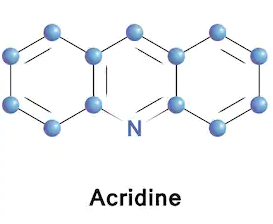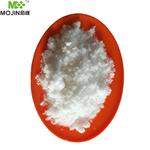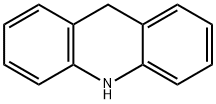Acridine
- CAS No.
- 260-94-6
- Chemical Name:
- Acridine
- Synonyms
- Akridin;10-Azaanthracene;DIBENZO[B,E]PYRIDINE;ACRIDINE;Acrydine;NSC 3408;Aceridine;Acridine >ACRIDINE 97%;Acridine, 98+%
- CBNumber:
- CB9853399
- Molecular Formula:
- C13H9N
- Molecular Weight:
- 179.22
- MDL Number:
- MFCD00005025
- MOL File:
- 260-94-6.mol
- MSDS File:
- SDS
| Melting point | 106-109 °C |
|---|---|
| Boiling point | 346 °C(lit.) |
| Density | 1,005 g/cm3 |
| refractive index | 1.7270 (estimate) |
| Flash point | 346°C |
| storage temp. | Refrigerator |
| solubility | dioxane: 0.1 g/mL, clear |
| pka | 5.58(at 20℃) |
| form | Crystalline Powder |
| color | Yellow to yellow-brown |
| PH Range | Green B uorescence (5.2) to violet B uorescence (6.6) |
| Water Solubility | 57.35mg/L(24 ºC) |
| λmax | 358nm, 392nm |
| Merck | 14,122 |
| BRN | 120200 |
| Exposure limits | OSHA: TWA 0.2 mg/m3 |
| Stability | Stable. Combustible. Incompatible with strong oxidizing agents. |
| Major Application | Organic light-emitting diode, photoresists, nanosensors, fuel cells, memory device, semiconductors, information storage device, liquid crystal displays, identification of product forgeries, inks, adhesives, textile, hair dyes, gene detection assay, staining cells, biosensors, detecting nucleic acids, proteins, antiHCV antibodies, antibacterial, antiamyloid agents, wound dressing materials, vaccines against infection, allergy and cancer |
| InChIKey | DZBUGLKDJFMEHC-UHFFFAOYSA-N |
| LogP | 3.400 |
| CAS DataBase Reference | 260-94-6(CAS DataBase Reference) |
| EWG's Food Scores | 1 |
| FDA UNII | 42NI1P5Q1X |
| EPA Substance Registry System | Acridine (260-94-6) |
SAFETY
Risk and Safety Statements
| Symbol(GHS) |   GHS07,GHS09 |
|||||||||
|---|---|---|---|---|---|---|---|---|---|---|
| Signal word | Warning | |||||||||
| Hazard statements | H302-H315-H319-H335-H410 | |||||||||
| Precautionary statements | P261-P264-P273-P301+P312-P302+P352-P305+P351+P338 | |||||||||
| Hazard Codes | Xn | |||||||||
| Risk Statements | 22-68-36/37/38 | |||||||||
| Safety Statements | 22-36-45-36/37/39-26 | |||||||||
| RIDADR | UN 2713 6.1/PG 3 | |||||||||
| WGK Germany | 3 | |||||||||
| RTECS | AR7175000 | |||||||||
| TSCA | Yes | |||||||||
| HazardClass | 6.1 | |||||||||
| PackingGroup | III | |||||||||
| HS Code | 29333990 | |||||||||
| Toxicity | LD50 s.c. in mice: 0.40 g/kg (Rubbo) | |||||||||
| NFPA 704 |
|
Acridine price More Price(32)
| Manufacturer | Product number | Product description | CAS number | Packaging | Price | Updated | Buy |
|---|---|---|---|---|---|---|---|
| Sigma-Aldrich | 01640 | Acridine BioReagent, suitable for fluorescence, ≥97.0% (HPLC) | 260-94-6 | 1g | $54.4 | 2024-03-01 | Buy |
| Sigma-Aldrich | 01640 | Acridine BioReagent, suitable for fluorescence, ≥97.0% (HPLC) | 260-94-6 | 10g | $128 | 2024-03-01 | Buy |
| TCI Chemical | A0129 | Acridine Zone Refined (number of passes:45) >99.0%(HPLC)(T) | 260-94-6 | 1sample | $257 | 2022-04-27 | Buy |
| TCI Chemical | A0294 | Acridine >98.0%(HPLC)(T) | 260-94-6 | 5g | $153 | 2024-03-01 | Buy |
| Alfa Aesar | L01657 | Acridine, 97% | 260-94-6 | 5g | $53.5 | 2024-03-01 | Buy |
Acridine Chemical Properties,Uses,Production
Applications
Several dyes and drugs feature the acridine skeleton. Many acridines, such as proflavine, also have antiseptic properties. Acridine and related derivatives (such as amsacrine) bind to DNA and RNA due to their abilities to intercalate. Acridine orange (3,6-dimethylaminoacridine) is a nucleic acid-selective metachromatic stain useful for cell cycle determination.
Reactions
Acridine displays the reactions expected of an unsaturated N-heterocycle. It undergoes N-alkylation with alkyl iodides to form alkyl acridinium iodides, which are readily transformed by the action of alkaline potassium ferricyanide to N-alkyl acridones.
Basicity
Acridine and its homologues are weakly basic. Acridine is a photobase which has a ground state pKa of 5.1, similar to that of pyridine, and an excited state pKa of 10.6. It also shares properties with quinoline.
Reduction and oxidation
Acridines can be reduced to the 9,10-dihydroacridines, sometimes called leuco acridines. Reaction with potassium cyanide gives the 9-cyano-9,10-dehydro derivative. On oxidation with potassium permanganate, it yields acridinic acid (C9H5N(CO2H)2) otherwise known as quinoline-1,2-dicarboxylic acid. Acridine is easily oxidized by peroxymonosulfuric acid to the acridine amine oxide. The carbon 9-position of acridine is activated for addition reactions.
Chemical Properties
colourless to light yellow crystals
Uses
Acridine is a compound occurring in coal tar that has been used in the manufacture of dyes and intermediates. Derivatives are used as antiseptics (e.g., proflavine). Acridine is a strong irritant to mucous membranes and skin, and it causes sneezing on inhalation.
Uses
A quinoline derivative used as manufacturing dyes and as intermediate for antileishmanial agents. A catabolic product of carbamazepine (C175840) metabolite.
Uses
manufacture of dyes and intermediates; some dyes derived from it are used as antiseptics, e.g. 9-aminoacridine, acriflavine and proflavine. The hydrochloride has been used as reagent for cobalt, iron and zinc.
Definition
ChEBI: A polycyclic heteroarene that is anthracene in which one of the central CH groups is replaced by a nitrogen atom.
Definition
acridine: A colourless crystallineheterocyclic compound, C12H9N; m.p.110°C. The ring structure is similarto that of anthracene, with threefused rings, the centre ring containinga nitrogen heteroatom. Severalderivatives of acridine (such as acridineorange) are used as dyes or biologicalstains.
Definition
A colorless crystalline heterocyclic compound with three fused rings. Derivatives of acridine are used as dyes and biological stains.
brand name
Euflavin;Proflavin.
World Health Organization (WHO)
Acridine derivatives with antiseptic and disinfectant activity, including acriflavine, proflavine and euflavine, were formerly used in the treatment of infected wounds and burns. Such use has largely been discontinued on the grounds that safer and more effective alternatives are now available. Following demonstration of the mutagenic activity of proflavine in 1978 it was withdrawn from dental products in Denmark. Subsequently, euflavine was similarly withdrawn.
Synthesis Reference(s)
The Journal of Organic Chemistry, 21, p. 1286, 1956 DOI: 10.1021/jo01117a019
Synthesis, p. 732, 1987 DOI: 10.1055/s-1987-28066
General Description
Small colorless needle-like crystalline solid. Slightly soluble in hot water. Slightly denser than water. Contact may irritate skin, eyes, and mucous membranes. Sublimes before melting when heated. May be toxic by ingestion.
Air & Water Reactions
Slightly soluble in hot water.
Reactivity Profile
Acridine neutralizes acids in exothermic reactions to form salts plus water. May be incompatible with isocyanates, halogenated organics, peroxides, phenols (acidic), epoxides, anhydrides, and acid halides. Flammable gaseous hydrogen may be generated in combination with strong reducing agents, such as hydrides. Burns to give toxic oxides of nitrogen.
Health Hazard
Inhalation irritates respiratory system and causes sneezing, crying, and vomiting. Contact with liquid irritates eyes, skin, and mucous membranes. At high temperature and during sun exposure, damage to the cornea, skin, and mucous membranes may occur following the liberation of Acridine vapor.
Safety Profile
Poison by ingestion, subcutaneous, and intravenous routes. Mutation data reported. A skin, eye, and mucous membrane irritant. When heated to decomposition it emits toxic fumes of NO,.
Potential Exposure
Acridine and its derivatives are widely used in the production of dyestuffs, such as acriflavine, benzoflavine, and chrysaniline; and in the synthesis of pharmaceuticals; such as aurinacrine, proflavine, and rivanol. A constituent of coal tar, coal tar creosote; found in wastes from gas and tar plants and coke oven emissions. Incompatibilities: Strong acids, strong oxidizers.
Shipping
UN2713 Acridine, Hazard Class: 6.1; Labels: 6.1-Poisonous materials
Purification Methods
Acridine has been crystallised twice from *benzene/cyclohexane, or from aqueous EtOH, then sublimed, removing and discarding the first 25% of the sublimate. The remainder is again crystallised and sublimed, discarding the first 10-15% [Wolf & Anderson J Am Chem Soc 77 1608 1955]. Acridine can also be purified by crystallisation from n-heptane and then from ethanol/water after pre-treatment with activated charcoal, or by chromatography on alumina with pet ether in a darkened room. Alternatively, acridine can be precipitated as the hydrochloride from *benzene solution by adding HCl, after which the base is regenerated, dried at 110o/50mm, and recrystallised to constant melting point from pet ether [Cumper et al. J Chem Soc 4518 1962]. The regenerated free base may be recrystallised, chromatographed on basic alumina, then vacuum-sublimed and zone-refined. [Williams & Clarke, J Chem Soc, Faraday Trans 1 73 514 1977, Albert, The Acridines Arnold Press 1966.] It can exist in five crystalline forms and is steam volatile. It is a strong IRRITANT to skin and mucous membranes and can become a chronic irritant— handle it with CARE. [Beilstein 20/8 V 199.]
Incompatibilities
Acridine and its derivatives are widely used in the production of dyestuffs, such as acriflavine, benzoflavine, and chrysaniline; and in the synthesis of pharmaceuticals; such as aurinacrine, proflavine, and rivanol. A constituent of coal tar, coal tar creosote; found in wastes from gas and tar plants and coke oven emissions. Incompatibilities: Strong acids, strong oxidizers.
Waste Disposal
Incineration with nitrogen oxide removal from the effluent gas by scrubber, catalytic, or thermal device.
Acridine Preparation Products And Raw materials
Raw materials
1of3
Preparation Products
| Supplier | Tel | Country | ProdList | Advantage | |
|---|---|---|---|---|---|
| Wuhan Kemi-Works Chemical Co., Ltd. | +86-2785736489 +8618171418573 | sales@kemiworks.com | China | 704 | 58 |
| Henan Tianfu Chemical Co.,Ltd. | +86-0371-55170693 +86-19937530512 | info@tianfuchem.com | China | 21691 | 55 |
| Hangzhou FandaChem Co.,Ltd. | 008657128800458; +8615858145714 | fandachem@gmail.com | China | 9348 | 55 |
| career henan chemical co | +86-0371-86658258 | sales@coreychem.com | China | 29914 | 58 |
| Zhengzhou Yuanli Biological Technology Co., Ltd | 0086-371-67897895 | info@zzyuanli.cn | CHINA | 136 | 58 |
| Patience Biological Engineering (Shanghai)Co.,Ltd. | 13818903334 | admin@pssh.com.cn | CHINA | 2 | 58 |
| Hubei xin bonus chemical co. LTD | 86-13657291602 | linda@hubeijusheng.com | CHINA | 22968 | 58 |
| BOC Sciences | +1-631-485-4226 | inquiry@bocsci.com | United States | 19553 | 58 |
| Chongqing Chemdad Co., Ltd | +86-023-61398051 +8613650506873 | sales@chemdad.com | China | 39916 | 58 |
| Shaanxi Dideu Medichem Co. Ltd | +86-29-87569265 +86-18612256290 | 1056@dideu.com | China | 3581 | 58 |
View Lastest Price from Acridine manufacturers
| Image | Update time | Product | Price | Min. Order | Purity | Supply Ability | Manufacturer | |
|---|---|---|---|---|---|---|---|---|
 |
2023-01-31 | Acridine
260-94-6
|
US $100.00 / kg | 1kg | 98% | 5000kg | Hebei Mojin Biotechnology Co., Ltd | |
|
|
2021-11-02 | Acridine
260-94-6
|
US $65.00 / g | 5g | 99% | 100kg | Baoji Guokang Healthchem co.,ltd | |
 |
2021-07-20 | Acridine
260-94-6
|
US $0.00-0.00 / KG | 1g | 99% | 2000tons | Shaanxi Dideu Medichem Co. Ltd |
260-94-6(Acridine)Related Search:
1of4







